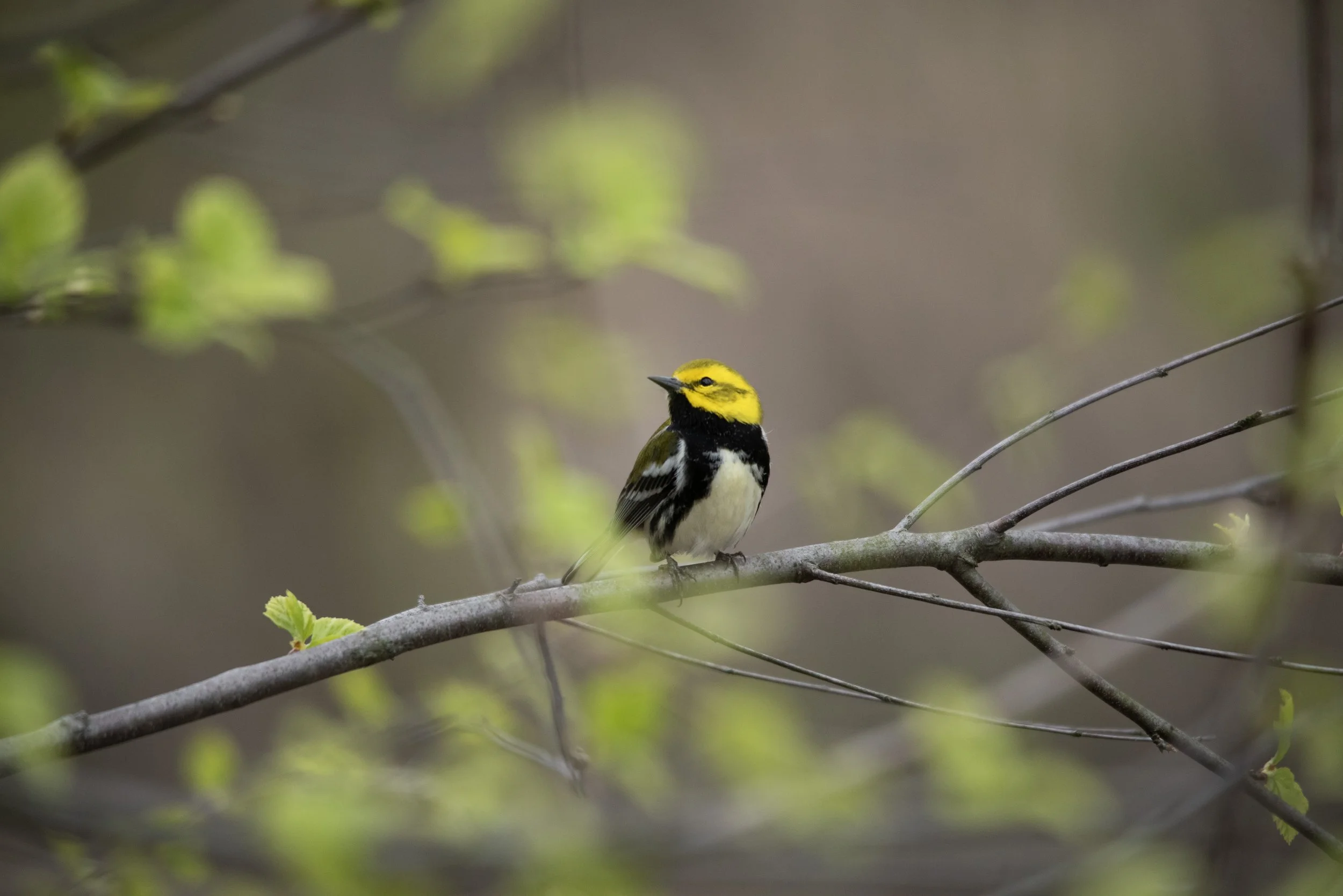Fall Migration
in Lorain County
A Sky Full of Stories
Article by Kyler Sonney, Senior Naturalist
Senior Naturalist, Kyler Sonney, leading a birding hike at Carlisle Reservation
As the golden hues of autumn roll across the woodlands and the crisp breeze carries the scent of falling leaves, something magical happens in the skies above Lorain County, Ohio. Birds—hundreds of thousands of them—begin an epic journey southward. From warblers weighing less than a quarter ounce to broad-winged hawks spiraling on thermal currents, fall migration is one of the most awe-inspiring natural events on Earth.
Lorain County, situated on the southern shore of Lake Erie, lies within the Mississippi and Atlantic Flyways. These migratory routes are akin to superhighways in the sky, guiding birds from the northern breeding grounds of Canada and the Great Lakes region to the warmer climates of the southern U.S., the Caribbean, and South America. Every fall, the county becomes a vital stopover for birds that depend on its diverse landscapes to rest and refuel before continuing their long flights.
This article explores the phenomenon of fall migration in Lorain County—from its ecological importance to the species you’re most likely to see. We’ll dive into local hotspots, examine the threats birds face, and offer ways you can get involved in protecting and celebrating this incredible spectacle. Whether you’re an experienced birder or a curious park-goer, this article aims to deepen your appreciation for the natural wonder unfolding just overhead.
What Is Bird Migration?
Bird migration is the seasonal movement of birds from one region to another, usually between breeding and wintering grounds. While spring migration gets much of the attention, fall migration is often more prolonged, more diverse, and in some ways, more exciting.
In autumn, adult birds and their newly fledged young begin the perilous journey southward. For some, it’s a short hop downstate. For others, it’s a transcontinental flight over mountains, deserts, and oceans. Migration is driven primarily by the changing availability of food and suitable habitat, as well as the photoperiod (day length).
Most songbirds migrate at night using celestial navigation and magnetic fields. Raptors and larger birds, like cranes or geese, often migrate during the day using thermals—rising columns of warm air that allow them to soar great distances without flapping.
Why Lorain County Matters
Lorain County offers the perfect blend of stopover habitats for migrants:
Lake Erie shoreline for waterbirds and gulls
Mature woodlands for songbirds and owls
Restored prairies for sparrows and raptors
Wetlands and marshes for shorebirds and waders
In particular, the lake effect plays a massive role. As birds reach Lake Erie, many funnel along the shoreline, especially when faced with poor weather or headwinds. This leads to “fallouts,” where birds descend in large numbers to rest and forage, offering an unparalleled birdwatching experience.
Local Hotspots for Fall Migration
Lakeview Park & Lorain Harbor
An excellent location for warblers, gulls, waterfowl, and even the occasional rarity. The breakwall and adjacent shrubs provide excellent habitat for tired migrants. Expect loons, grebes, and ducks in mid-to-late fall.
Black River Reservation
A fantastic corridor for raptors and songbirds alike. The trail system winds through forest, prairie, and riparian habitats. Look for migrating hawks and mixed flocks of chickadees, kinglets, and woodpeckers.
Carlisle Reservation
Home to meadows, mature woods, and wetlands, this site offers something for every type of migrant. Look for indigo buntings, eastern towhees, and northern harriers. The Equestrian Center section of the reservation, in particular, is a hidden gem for fall birding.
Wellington Reservation
Known for excellent wetland habitats, this is a go-to location for rails, bitterns, and migrating dabbling ducks. Watch for sora and Virginia rail skulking in the cattails.
Oberlin Reservoir
A magnet for waterbirds and shorebirds, including phalaropes and rare gulls. Bring a scope, and scan for red-necked grebes, canvasbacks, and common goldeneye.
Conservation Challenges
Habitat Loss
Development continues to chip away at important stopover sites. Wetlands, grasslands, and shoreline habitats are all under pressure. Restoration and protection efforts by Lorain Metro Parks (LCMP) and partners are vital.
Light Pollution
Most songbirds migrate at night. Artificial lighting from cities and industrial areas can disorient birds, leading to collisions or exhaustion. Promoting “Lights Out” initiatives during peak migration can save lives.
Climate Change
Warmer temperatures can disrupt migration timing and alter the availability of food. Some species now migrate earlier or later than in past decades. Others may skip stopover sites entirely, threatening their survival.
Pesticides and Insects
Many migrating birds depend on insect prey. Neonicotinoid pesticides and habitat simplification have led to dramatic declines in insect biomass, particularly in agricultural regions.
Community Science and Bird Research
Lorain County is part of several major migration research efforts:
MOTUS Wildlife Tracking System: A network of automated radio telemetry towers tracks tagged birds in real time.
eBird: Every bird sighting submitted by citizens helps researchers monitor migration trends. Lorain County regularly ranks among the top Ohio counties for fall observations.
Lights Out Cleveland: Though based in the city, volunteers recover dead or injured birds and raise awareness about urban dangers to migrants.
How to Get Involved
Join a local bird walk at the Lorain County Metro Parks.
Keep a feeder stocked into fall—especially suet and sunflower for sparrows, woodpeckers, and late migrants.
Submit your sightings to eBird or iNaturalist.
Plant native shrubs and trees like dogwood, serviceberry, and oak, which provide food and shelter for migrants.
Advocate for habitat preservation by supporting LCMP and other conservation groups.
Tips for Watching Fall Migration
Go Early: Many birds are most active within a few hours of sunrise after night flights.
Scan the Sky: On sunny days, look for raptors riding thermals.
Use Aids: Bring binoculars and a field guide, or use apps like Merlin Bird ID.
Check eBird Hotspots: See where other birders are reporting activity.
Listen and Look: Kinglets, creepers, and warblers often give quiet chip notes as they feed.
Fall migration is not just a spectacle; it’s a story of survival, endurance, and natural wonder. Every bird that passes over Lorain County has overcome incredible odds. And every field, forest, and wetland in our parks could be a critical rest stop for an exhausted traveler.
By watching, learning, and protecting, we become part of that story. Whether you spot a single ruby-crowned kinglet flitting through the underbrush or marvel at a thousand snow geese winging across a copper sky, fall migration reminds us of the connections between land, sky, and life.
So, grab your binoculars, take a walk, and look up—you never know what marvel might be flying right overhead.



